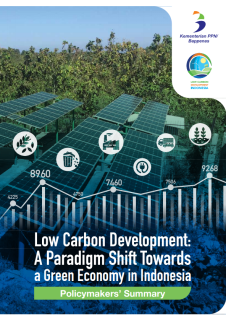This resource is also available in Indonesian.
Continuing down Indonesia’s current development path is unsustainable, limiting Indonesia’s growth, job creation, and potential to eradicate poverty.
It is with this understanding, that the Government of Indonesia has set out to transform the country's economy into one where progress is measured not only by GDP growth, but also environmental sustainability, resource efficiency, and social equity. That is the sustainable and inclusive growth story of Indonesia for the 21st century.
In October 2017, the Government of Indonesia declared its goal of integrating climate action into the country’s development agenda. The Low Carbon Development Initiative (LCDI) was launched at Indonesia’s Ministry of National Development Planning (BAPPENAS). It aims to explicitly incorporate greenhouse gas (GHG) emissions reduction targets into the policy planning exercise, along with other interventions for preserving and restoring natural resources.
The LCDI is a process for identifying development policies that maintain economic growth, alleviate poverty, and help meet sector-level development targets, while simultaneously helping Indonesia achieve its climate objectives, and preserve and improve the country’s natural resources.
Low carbon development policies are expected to be internalized into the upcoming National Medium-term Development Plan (RPJMN) 2020–2024. The medium-term development Plan is part of the implementation of the National Long-term Development Plan (RPJPN) 2005–2025, which seeks to establish a country that is developed and self-reliant, just and democratic, and peaceful and united. LCDI policies will be implemented to achieve the Indonesia Vision 2045.
This policymakers' summary of the report, Low Carbon Development Report: A paradigm shift towards a green economy in Indonesia, finds that a low carbon growth path can deliver an average GDP growth rate of 6% annually until 2045. It would unlock an array of economic, social, and environmental benefits. Additionally, through the sustainable utilization of its natural resources, and by reducing its carbon and energy intensity, Indonesia’s total GHG emissions can fall by nearly 43% by 2030. This surpasses Indonesia’s conditional target in its national climate action plan, or Nationally Determined Contribution (NDC), presently set at 41% below baseline.
The full report in English can be found here.
A brief can be found here.

